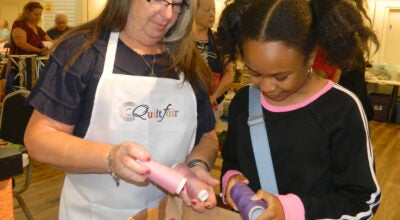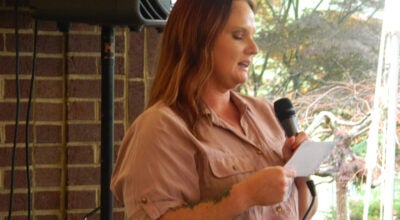Published 12:00 am Monday, May 7, 2012
By Mack Williams
For the Salisbury Post
When I was growing up, our kitchen was much different than those of today. The little pot-bellied stove in the corner burned coal and had a stovepipe oven which my father added. He looked everywhere to find it, only being able to locate it at the one place in Salisbury of which it was said at the time that everything could be found: O.O. Rufty’s. In that stovepipe oven, he baked the best cracklin’ cornbread!
The gas range was at the opposite end of the room (out of reach of the little coal stove’s sparks). Unlike some of the modern showroom kitchens, there was no central workspace, with countertop consisting of marble slabs or polished porphyritic granite.
We didn’t have a separate room for our wringer washing machine; it was kept on the back porch. The “dryer” was even further removed, being strung between two trees in the backyard. As there was no room in the kitchen for it, the washing machine was kept on the back porch; and as there was no electricity on the back porch, the washing machine (due to the fortunate circumstance of its having wheels) was rolled into the kitchen where it was plugged in for the duration of the wash.
With evolutionary advances, humans became more ambulatory, whereas with technological evolution, the wringer washing machine changed into something more static, without wheels or rollers. The argument, “What you don’t use, you lose,” can’t be made in the case of our wringer washing machine, because I vividly remember my mother wheeling it in, washing and running the completed wash through the rollers quite often. The overall demise of the wringer was not due to lack of use, of course, but instead to the advent of better technology and design.
To me, the word wringer should have been replaced with the word roller, since no twisting of the wet laundry seemed to be involved. Perhaps the term was a holdover from the days of the manual twisting of clothes just above the waters of a stream, the excess water dripping back below and continuing on in its temporarily interrupted flow. The verb form of the word wringer is also applied to that which is done to the neck of a chicken in the first step toward making the chicken more amenable to the idea of becoming dinner, but thankfully I don’t remember ever witnessing that term’s physical application.
Concerning our old gas range, I have memories, both visual and olfactory in nature, regarding its pilot light. There are wonderful sermons paralleling the Holy Ghost and the “lighthouse,” as well as sacred songs which also make that same reference, but I once heard a TV preacher use the term “pilot light” as his inspiration for comparison with the ever-present Holy Ghost. I would not have used that particular analogy, as I remember our stove’s pilot light always smelling quite disconcertingly gaseous, with a hint of sulphur, bearing a resemblance to the place which is Heaven’s complete antithesis, where the smell of heated brimstone pervades.
Leading off to one side, just beyond the refrigerator, was a small curtained pantry, the floor of which contained sacks of potatoes and bags of onions, both sometimes in various stages of sprouting (always coming in handy for use as a grade school, spur-of-the-moment, mini science project). There were opposing, library-like shelves which contained canned and labeled “volumes” of the necessary staples of nutrition. As far as this “library” was concerned, being “well-read” meant dietary sufficiency.
On those current cable channels devoted solely to the marketing of houses, kitchens are shown with abundant built-in cabinet space, above and below, sometimes wrapped around the entire kitchen’s inner circumference. When I was growing up, we didn’t have this; we had something which stood alone, combining storage space in cabinets, both above and below for additional canned goods, pots and pans, plates, coffee cups, saucers, cleansers (Bon Ami), a separate place for the storage of flour, (loose, not in a zip-loc bag or tin) with a built-in sifter (kind of like having one’s own little hand-cranked flour mill) and a sugar bowl (I can’t remember if it was included or added) with Mason-jar style, screw-cap lid to keep out the ants. There was a recessed space in front for the storage of spices, condiments, etc., drawers for the storage of eating utensils, napkins, placemats and a pull-out work shelf for the preparation of the things which were to be cooked. The shelf was metal and covered with white enamel, which to me had the look of ivory.
In one area along the pull-out shelf’s edge, I remember a section where some of its enamel covering had been worn away over the years, revealing the underlying metal. At that spot, there seemed to be a gradual gradient from enamel to the exposed metal below, not a clean break, as if the solid, opaque enamel still had the properties of a liquid, with the edge of its wearing away having the same watered-down look as that of semi-opaque skim milk on a spoon, beneath which the underlying metal can be seen.
This whole assemblage of handiness was called the kitchen cabinet cupboard, and ours was painted white, which I think was the standard color. It was portable by truck from the store; the only thing required for its activation for readiness consisted of its being carried into the kitchen and properly, vertically set up.
In the case of the myriad of handy kitchen gadgets which have been hawked for years over the television airwaves, I’ve yet to see anything to equal the utility of the kitchen cabinet cupboard. Paraphrasing a phrase from a late tyrant of the Middle East, it could have truly been referred to as “The mother of all gadgets,” because of its diverse components, the only other item of the present day to which I can liken it is the Swiss Army Knife.
I don’t remember what happened to our old kitchen cabinet cupboard. When my mother moved to Salisbury in 1974, she probably either sold it or gave it away. It was long gone before my friends Charlie and Pam (who now live there) gave me a tour of my old home when I made a return visit for the first time in 2009 after an absence of 35 years. Even with the many improvements made by Charlie and Pam, along with those made by whomever immediately preceded them, it still seemed a little strange that the old four-legged “handiwork of handiness” was no longer a part of that kitchen.
If it still exists somewhere in one piece, its present owner is in possession of an appreciable portion of my childhood kitchen, and in some sort of sense, also possesses a certain percentage of me.





